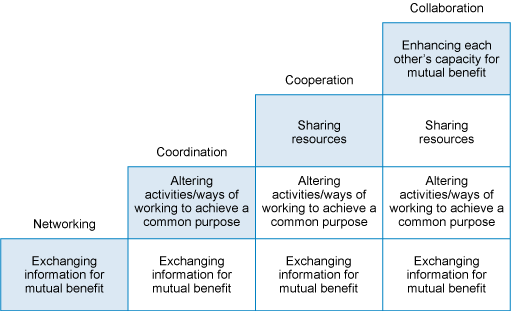4.2 Levels of partnership
As we have seen, partnership working can involve different levels of formality and commitment, from work based on quite loose and informal networks at one end of the spectrum, through to working arrangements based on formal agreements and organisational structures at the other. A model of partnership, where the different levels of commitment are built up step by step, is illustrated in Figure 7.
Networking is the most informal level of partnership working. There needs to be a minimal level of trust and willingness to share information, and the contacts are usually made informally, person to person rather than organisation to organisation.
Coordination goes a step further, adding altered activities or ways of working to networking behaviours. Coordination can help to address problems of fragmentation, overlap and duplication in services.
Cooperation moves the partners up another step. At this level organisations might share resources – including money, staffing and buildings.
Collaboration, at the top of the ‘staircase’, involves enhancing the partner so that both benefit. This is a top level partnership, with each person or organisation helping their partners to become better at what they do.
There are three key factors which influence the level of partnerships which can be reached - the three Ts of:
- Time (how much time is available),
- Trust (how well the people involved know and trust each other) and
- Turf (how high is the potential for turf wars, based on different values and purposes, readiness for power sharing, cultural differences, and so on).
Activity 7 What kind of partnership?
Working in your learning journal and thinking of the range of service providers and voluntary organisations you work alongside, (other than the one you work for or may be part of), who do you think is the key partner in helping you contribute to community safety?
Thinking of the four levels of partnership in the staircase diagram in Figure 7 above, how would you characterise the partnership you have with this group or organisation?
Assess the three T’s in your partnership as follows:
- i.How much time is available to work in partnership?
- ii.How well do the people involved know and trust each other?
- iii.How high is the potential for ‘turf wars’ based different values, purposes, power and cultures
Discussion
Most partnerships working in community settings are based on a lot of mutual goodwill and understanding of the common purpose around such values as community well-being and safety. However the lack of time to establish regular and ongoing communications between partner groups, and the organisational tendency to defend particular patches of ‘turf’ or jurisdiction, can undermine this goodwill.
Developing a partnership is often not as simple as ascending the kind of ‘staircase’ shown in figure 7. For example, sometimes two public service teams, e.g. fire service and police response teams, may share resources like a central operations building or station, and share information extensively, but they often do not work in collaboration because they have not adopted joint or common ways of working. The best they may achieve is coordination of call-out responses.

